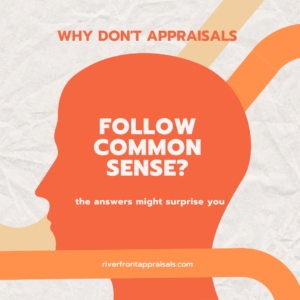
FAQ #19: What Are Some Of The Craziest Things You’ve Heard As An Appraiser?
I feel like we all need a laugh. How about

In my last post, I discussed why location is still the most important factor in real estate. Today, we’ll dig deeper and look at a few real examples of neighborhoods. If you’re wondering how an appraiser chooses his or her comparable sales, this is a must-read.
Example #1
So let’s say I’m appraising a home on Griffith Avenue in the west central portion of Owensboro. Griffith Avenue is a very special street, full of some of the grandest, most beautiful homes in our area. And, there is a stretch of Griffith Avenue which commands a premium price tag for name only. When I’m appraising a home on Griffith, I’m going to want to stay as close to Griffith as possible in my search for comparable sales. Buyers who are looking at purchasing on Griffith Avenue are doing so because they want to live in that area of town; they want that Griffith Avenue address. Most purchasers will not be looking at Griffith Avenue, as well as – to give one example – Lake Forest on the east side (although, there are always exceptions to the rule).
Example #2
What about an area of town which does not command a premium based on name alone? Further down Frederica Street is the Town & Country neighborhood. This is a neighborhood made up of mostly one and 1.5 story homes 20-50 years old with no basements, and close to the central/southern part of Owensboro. When choosing comparable sales for a home in Town & Country, the first thing I will look for are sales in Town & Country (this really isn’t rocket science!). I would not look to Thorobred East on the east side of Owensboro, nor Bon Harbor in the northwest portion. Nor would I look to any other location, unless there were absolutely no comparable sales in the subject’s neighborhood.
You might be asking yourself, “Where do appraisers come up with these rules?” That’s a great question! Although we have to comply with many local, state, and federal regulations, Fannie Mae trumps them all in most cases. The Fannie Mae Selling Guide states that “Comparable sales from within the same neighborhood (including subdivision or project) as the subject property should be used when possible, and must be used in certain instances … Sale activity from within the neighborhood is the best indicator of value for properties in that neighborhood as sales prices of comparable properties from the same location should reflect the same positive and negative location characteristics.”
That last part bears repeating. “Sale activity from within the neighborhood is the best indicator of value for properties in that neighborhood…”
Although not a requirement, most lenders like to see comparable sales located less than 1/2 mile from the subject for an urban location; one mile in a suburban location; and up to 10 miles in a rural location. These are just guidelines, however, and can be extended with good reason. Take, for example, McLean County. This is a very large county with few annual sales. It is not uncommon for comparable sales to be located 15-25 miles from the subject property.
The Exception to the Rule
Are we saying this whole ‘location is king’ thing is true every time? Not at all. So when would an appraiser need to go outside a subject’s neighborhood to find comparable sales?
There are times when leaving a subject’s neighborhood might be necessary. Take for instance, if I’m appraising a home in Neighborhood A, and the home has an inground pool, but I can’t locate any recent comparable sales in Neighborhood A with an inground pool. Pools in this neighborhood influence value, and therefore I would definitely want to find a recent sale with such an amenity (even if it means going to Neighborhood C or D) to support any adjustment given for pools.
House style can also trump location. If you’re selling an earth-berm home, I know that underwriters are going to want to see sales of similar-style homes. Chances are, there’s not three sales of earth-berm homes within a 10-mile radius which sold in the last 12 months. In this case, and in this rural market, we usually need to expand our search to up to 25+/- miles and within 24 months from the date of our appraisal, just to find comparable sales. In situations like this, the homeowner may not be purchasing location as much as home style. When we appraise a home of atypical design, we usually try to find homes similar to the subject regardless of location, as well as sales in the same location, but which might not be comparable in design.
Conclusion
So there you have it. Although there will always be exceptions to the rule, location is – and will remain – the most important value-contributing factor in real estate. Location, location, location. True 100 years ago. True today. And, likely true 100 years from now.

I feel like we all need a laugh. How about

So this may be a slight break from the norm,

Selling your home can be a major financial decision, and
Riverfront Appraisals has been providing comprehensive valuations of residential properties to Western Kentucky and Southwestern Indiana since 2008.